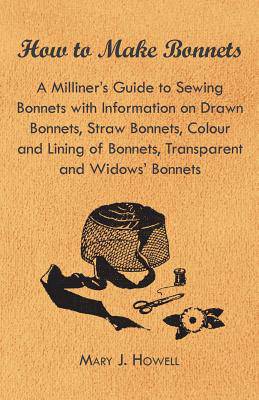
Door een staking bij bpost kan je online bestelling op dit moment iets langer onderweg zijn dan voorzien. Dringend iets nodig? Onze winkels ontvangen jou met open armen!
- Afhalen na 1 uur in een winkel met voorraad
- Gratis thuislevering in België vanaf € 30
- Ruim aanbod met 7 miljoen producten
Door een staking bij bpost kan je online bestelling op dit moment iets langer onderweg zijn dan voorzien. Dringend iets nodig? Onze winkels ontvangen jou met open armen!
- Afhalen na 1 uur in een winkel met voorraad
- Gratis thuislevering in België vanaf € 30
- Ruim aanbod met 7 miljoen producten
Zoeken
How to Make Bonnets - A Milliner's Guide to Sewing Bonnets with Information on Drawn Bonnets, Straw Bonnets, Colour and Lining of Bonnets, Transparent
Mary J Howell
Paperback | Engels
€ 36,95
+ 73 punten
Omschrijving
This antique text contains a detailed and beginner-friendly guide to creating bonnets, with special emphasis on drawn bonnets, straw bonnets, the colouring and lining of bonnets, and transparent and widows' bonnets. How to Make Bonnets is the perfect book for those with an interest in the designing and manufacturing of bonnets, and constitutes a great addition to any collection of antiquarian hatmaking literature. Chapters contained herein include: 'On Drawn Bonnets--with flat and raised grooves--and Capotes in general'; 'On the most eligible method to be adopted for the lining of Straw and other Bonnets'; 'On the making and cutting of Tight Bonnets with Due Attention to Economy'; 'Observations on the Adoption of Colours Best Calculated to Suit the Complexion'; 'On Transparent Bonnets'; and 'On Widows' Caps'. We are proud to republish this book here complete with a new introduction to the subject.
Specificaties
Betrokkenen
- Auteur(s):
- Uitgeverij:
Inhoud
- Aantal bladzijden:
- 56
- Taal:
- Engels
Eigenschappen
- Productcode (EAN):
- 9781447412823
- Verschijningsdatum:
- 1/06/2011
- Uitvoering:
- Paperback
- Formaat:
- Trade paperback (VS)
- Afmetingen:
- 140 mm x 216 mm
- Gewicht:
- 81 g

Alleen bij Standaard Boekhandel
+ 73 punten op je klantenkaart van Standaard Boekhandel
Beoordelingen
We publiceren alleen reviews die voldoen aan de voorwaarden voor reviews. Bekijk onze voorwaarden voor reviews.











